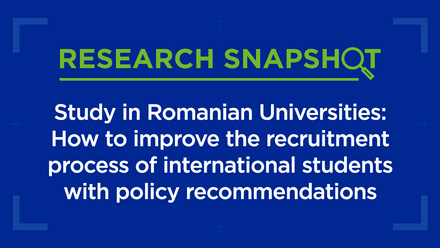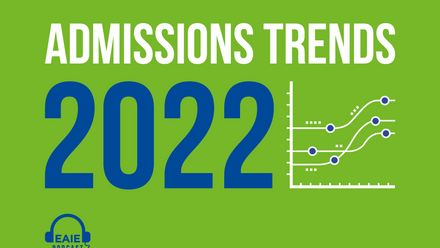Getting strategic about enrolment management

While we often think that prospective students choose not to enrol in our university for reasons outside of our control – such as politics, cost, climate, rankings, academic programme choice or quality – what about the factors that are within our control?
In many cases, business processes and practices related to recruitment, admission, marketing and student support services function the way they do simply because that’s how it’s always been done. However, this can often create unnecessary obstacles, such as poor internal communication between offices with different functional responsibilities, infrastructural and operational inefficiencies, and a lack of transparency about employment outcomes of a particular programme.
What is international strategic enrolment management?
As defined by Suzanne Alexander, “Strategic enrolment management (SEM) is a comprehensive, institution-wide process which involves analysis of markets, supply and demand, marketing, recruitment as well as internal organisation matters, programme development, admissions processes and student support services. International strategic enrolment management (ISEM) applies the concepts associated with SEM, and gives them an international perspective: attracting, engaging, recruiting and supporting international students.” Integration and collaboration thus play a critical role in ISEM.
Additionally, the Association for Graduate Enrollment Management (NAGAP) Research and Global Issues Committee led a practitioner-based research project on graduate enrolment management. What emerged from the research was a model of Integrated Interdependence, a holistic view of co-dependent functions that work together in support of the student life cycle. The model continues to be cited as a primary reference in articles, university strategic planning documents and workshops with numerous organisations.
In fact, this kind of focus on integrated strategic enrolment approach has helped one US institution, the University at Buffalo, School of Engineering and Applied Sciences – facing increasing global competition and double-digit national declines – to buck trends by increasing overall enrolment for four consecutive years, including a 33% increase in international enrolments in one of those years, and increasing the number of sending countries from 20 to 30 despite the challenging geopolitical landscape.
There are many elements within our reach that can make a positive difference on enrolment outcomes with immediate impact. No matter what your enrolment goals are, it is important to ask a series of critical questions in looking at your existing enrolment framework. For starters, here are 10 questions to consider:
1. Are you leveraging all your existing networks?
Are you currently leveraging all of your existing networks in your international recruitment, admissions, yield enhancement, new student on-boarding and enrolment processes? That includes those who supply letters of recommendation, alumni, current and former applicants with any admissions decision status, etc. These are just a few examples of the many more opportunities that exist in your current network.
2. Do you recycle existing applicants?
Do you recycle existing International applicants, including academically qualified rejected applicants, who are already in your pool via ‘pathways’ or a ‘merit-based’ admissions process”? By thinking through the programmes you currently administer or by collaborating with those at your university who administer other similar programmes, there are numerous ways to yield these applicants through to enrolment, providing them access to education.
3. Are you capitalising on authoritative content?
Do you capitalise on available authoritative content that bridges the gap between your academic programmes and the current job market demand? Applicants seek programmes that will enhance their ability to secure employment after school. Information from authoritative sources (ie job outcomes of your recent graduates, academic trade journals, Forbes etc) provides rich recruitment content to use in your communication plan.
4. Have you thought about student assimilation?
Do you have concerns regarding new international student assimilation? In many cases, this is the first journey for these students setting foot outside of their respective countries, and there is an understandable adjustment to professionalism, ethics etc. The support services we provide must be transparent, integrated and sustainable.
5. Can you diagram the prospective student’s journey?
Can you diagram with certainty the journey through your university business processes an international prospect takes through to matriculation/enrolment? Given the extra regulatory steps required, the journey or hand-off of a prospective international student in the enrolment funnel can be murky at best. Rather than relying on business processes based on folklore, we need to identify weaknesses and engage in solutions.
6. Are silos getting in the way?
Could silos in your university be creating inefficiencies? Walls between functional areas (eg admissions, marketing, student services, international) can create friction throughout the student lifecycle, making it more difficult for prospective students to move from recruitment to applicant to acceptance to enrolment and the resulting student success. Internal university fiefdoms and territoriality can come at the cost of successfully yielding or retaining a student.
7. What about student services?
How are student services being engaged and leveraged in the recruitment, admissions and onboarding phases through to enrolment? The recruitment of students (especially international students) is one of integrated interdependence, starting with the initial point of interest and continuing through the admissions process to enrolment, the student experience to graduation and beyond.
8. What tools and data models could be helpful?
Are you interested in learning more about tools and models that can assist in providing you with better data and proactively predicting enrolment outcomes? Historical data elements you currently have access to, coupled with enrolment benchmarks such as surveys and orientation forms, can provide you a very accurate picture of enrolment outcomes.
9. What message are your admissions requirements sending?
Have you thought about the fact that your published admissions requirements may not only be helping you, but they could also be negatively impacting your ability to recruit international students? While it is important to be transparent about establishing expectations, unneeded requirements or being too specific may in fact turn away the very applicants you may be looking to attract.
10. Are your programmes relevant?
Do your programmes demand interest by realistically aligning with local, national and international labour markets? Labour markets fluctuate and over time sub-disciplines within academic programmes can emerge as in higher demand than their original parent disciplines. These can be used to create new programs or reframe existing curriculum.
If you found any of these questions thought-provoking or difficult to answer, that may indicate that you’re missing out on opportunities to be better integrated and more strategic in your approach to international enrolment management.






